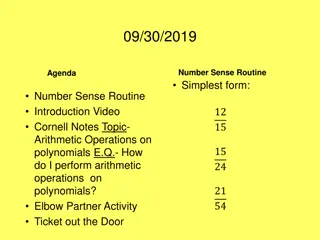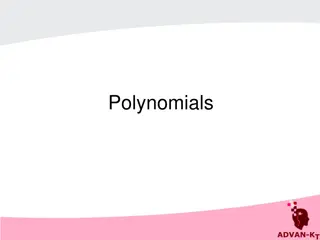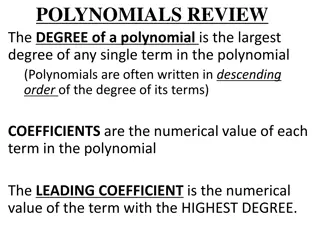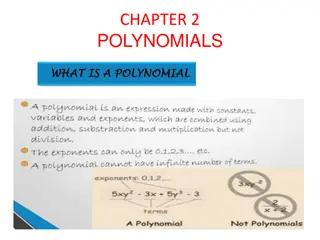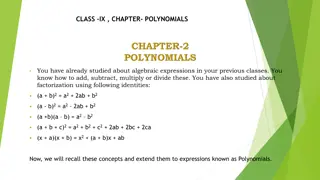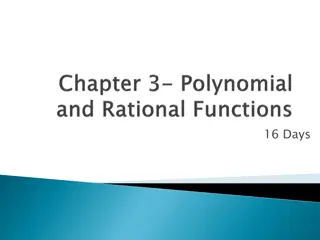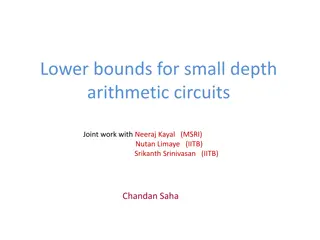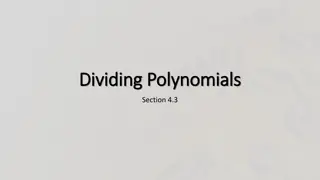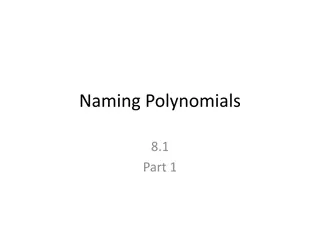Understanding Polynomials in Mathematics
Explore the concept of polynomials in mathematics, including the geometrical meaning of zeroes, the relationship between zeroes and coefficients, and the division algorithm. Learn about the degree of polynomials, value of polynomials, and how to identify and factorize them. Discover algebraic expressions and terms, as well as the standard form of polynomials and their degrees. Enhance your understanding of algebraic concepts and their applications through this comprehensive guide.
Uploaded on Aug 14, 2024 | 0 Views
Download Presentation

Please find below an Image/Link to download the presentation.
The content on the website is provided AS IS for your information and personal use only. It may not be sold, licensed, or shared on other websites without obtaining consent from the author. Download presentation by click this link. If you encounter any issues during the download, it is possible that the publisher has removed the file from their server.
E N D
Presentation Transcript
DAV INSTITUTIONS, ODISHA ZONE-1 CLASS-X SUBJECT:MATHEMATICS TOPIC : POLYNOMIALS
CHAPTER-2 (POLYNOMIALS) CONTENTS Introduction. Geometrical Meaning of Zeroes of a Polynomial. Relationship Between Zeroes and coefficients of a Polynomial. Division Algorithm for Polynomials.
LEARNING OBJECTIVES: Students will be able to recall the concept of polynomials, degree of polynomials, value of a polynomials and zeroes of the polynomials. They will be able to present the zeroes of the polynomials geometrically and identify the zeroes from it. They will be able to identify the number of zeroes and types of graph for different polynomials. They will be able to apply the relationship between the zeroes and coefficients of a polynomial to find the zeroes and nature of the zeroes. They will be able to find the factors of polynomial s when some factors are given by using Division Algorithm to it. They will be able to factorize a polynomial to find the number of linear factors it has by applying Factor theorem , Remainder theorem and Division Algorithm.
SESSION-1 Introduction to Polynomials
Algebraic Expressions An algebraic expression is an expression made up of variables and constants along with mathematical operators. Aterm is a product of variables and constants. A term can be an algebraic expression in itself. Examples of a term : 3 ,which is just a constant. 2x, which is the product of constant 2 and the variable x 4xy, which is the product of the constant 4 and the variables x and y . 5x2y, which is the product of 5, x, x and y. The constant in each term is referred to as the Numerical coefficient. Example of an algebraic expression : 3x2y+4xy+5x+6 which is the sum of four terms 3x2y, 4xy, 5x and 6 An algebraic expression can have any number of terms. The coefficient in each term can be any real number. There can be any number of variables in an algebraic expression. The exponent on the variables, however, must be rational numbers.
Polynomial An algebraic expression can have exponents as rational numbers. However, a polynomial is an algebraic expression in which the exponent on any variable is a whole number or we may say non negative integers. 5x3+3x+1 is an example of a polynomial. It is an algebraic expression as well. 2x+3 x is an algebraic expression, but not a polynomial. since the exponent of x is 1/2 which is not a whole number. STANDARD FORM: anxn+an-1xn-1+ ..+a1x1+a0x0 Where n is a non negative integers. a0, a1, anare constants (Real numbers)
Degree of a Polynomial For a polynomial in one variable the highest exponent on the variable in a polynomial is the degree of the polynomial. Example: The degree of the polynomial x2+2x+3 is 2, as the highest power of x in the given expression is 2. TYPES OF POLYNOMIALS Polynomials can be classified based on a) Number of terms b) Degree of the polynomial. Types of polynomials based on the number of terms a) Monomial : A polynomial with just one term. Example 2x, 6x2, 9xy b) Binomial : A polynomial with two terms. Example : 4x2+x, 5x+4 a) Trinomial : A polynomial with three terms. Example : x2+3x+4
Types of Polynomials based on Degree Constant polynomial. A polynomial whose degree is zero is called as constant polynomial Standard form:ax0 For example, 25,9, 5 etc. Zero Polynomial However though 0 is a constant, we are not considering it as a Constant Polynomial ;rather we consider it as a special polynomial named as Zero Polynomial. So the Degree of the Zero Polynomial is undefined. Linear Polynomial. A polynomial whose degree is one is called a linear polynomial. Standard form : ax+bwhere a ,b are real nos,a 0 For example, 2x+1 is a linear polynomial.
Quadratic Polynomial. A polynomial of degree two is called as quadratic polynomial. Standard form:ax2+bx+c where a ,b ,c are real numbers,a 0 For example, 3x2+8x+5 is a quadratic polynomial. Cubic Polynomial. A polynomial of degree three is called a cubic polynomial. Standard form:ax3+bx2+cx+d where a,b,c,d are real numbers, a 0 For example, 2x3+5x2+9x+15 is a cubic polynomial.
PRACTICE QUESTION ON SESSION-1 Multiple Choice Questions 1. The degree of polynomial x5 x4+ 7 is (a)5(b)4(c)2(d) 0 2.The degree of polynomial x3x 2+ 7 is (a)3(b)1(c)0(d) 2 3.Which of the following expressions are not polynomials. Give reason for your answer. (a) ?3+ ?+1 (c) (d) ?2+1 1 (b) x2+ x + 3 4. What will be value of p(3), if 3 is one of zero of polynomial p(x) = x3 2x + 9 ? (a)30(b)9(c)27(d)0 5. If 1 is one of the zeros of the polynomial x3+ 2x2+ x + k, the value of k is (a)1(b)4(c) 4(d)5 Fill in the blanks. 1.The maximum number of zeros that a polynomial of degree 3 can have is---------- 2.The number of zeros of a cubic polynomial is--------- 3. The degree of a constant polynomial is----- 4.A quadratic polynomial can have at most ---------zeroes- 5. A real number a is called a zero of the polynomial f(x),if ) f(a) = ---------- 6.The no of points the polynomial p(x) = x3+ 8 intersects with x-axis is ----------- Very Short Answer Type Questions 1. Classify the following as linear, bi-quadratic, cubic and constant polynomials. (i) 4m4+ 4m2 4m - 4 (ii) 8 (iii) 5x + 6x3-7x2 2 (iv) 9 - 2y 2. Is f(x) = ax + b called a linear polynomial? Justify.
SESSION-2 Graphical Presentation of polynomials
Graphical Representations Any Polynomial p(x) can be represented geometrically,where p(x) represents the value of the polynomial for different values of x we take. Each point on the graph represents the x and y coordinates of the point that satisfies x as value of the variable and y as the value of the polynomial. For example, the polynomial p(x)= x, on a graph, will be a straight line that joins all the points which have their x coordinate equal to their y coordinate. Example :(1,1), (2,2) and so on.
Visualization of a Polynomial Geometrical Representation of a Linear Polynomial The graph of a linear polynomial is a straight line. It cuts the x-axis at exactly one point. Linear graph
Geometrical Representation of a Quadratic Polynomial The graph of a quadratic polynomial is a parabola. It looks like a U which either opens upwards or opens downwards, depending on the value of a in ax2+bx+c. If a is positive then parabola opens upwards and if a is negative then it opens downwards. It can cut the x-axis at no point, one point or two points.
Graph of a polynomial which cuts the x-axis in two distinct points (a>0) Graph of a Quadratic polynomial which touches the x-axis at one point (a>0) Graph of a Quadratic polynomial that doesn t touch the x-axis (a<0)
Graph of the polynomial xn For a polynomial of the form p(x)=xn where n is a whole number: as n increases, the graph becomes steeper or draws closer to the y-axis. If n is odd, the graph lies in the first and third quadrants If n is even, the graph lies in the first and second quadrants. Graph of polynomials with different degrees.
PRACTICE QUESTIONS FOR SESSION-2. 1-Which of the following is not the graph of a quadratic polynomial? 2.What is the geometrical meaning of the zeroes of a polynomial? 3. Explain, what you understand by the expression of the form P (x) = a0+ a1x + a2x2+ a3x3+ .anxn 4 Name the point at which the graph represented by y = ax+ b crosses the x axis.
SESSION-3 Zeroes of a Polynomial and it s Geometrical Meaning
Zeroes of a Polynomial A zero of a polynomial p(x) is the value of x for which the value of p(x) is 0. If k is a zero of p(x), then p(k)=0. For example, consider a polynomial p(x)= x2 3x+2. When x=1, the value of p(x) will be equal to p(1)=12 3 1+2 =1 3+2 =0 Since p(x)=0 at x=1, we say that 1 is a zero of the polynomial x2 3x+2 .
Geometrical Meaning of Zeros of a Polynomial Geometrically, zeros of a polynomial are the points where its graph cuts the x-axis. (i) One zero Here A, B and C correspond to the zeros of the polynomial represented by the graphs (ii) Two zeros (iii) Three zeros
Number of Zeroes In a general polynomial of degree n has at most n zeroes. A linear polynomial has one zero, A quadratic polynomial has at most two zeros. A cubic polynomial has at most 3 zeros.
GEOMETRICAL REPRESENTATION OF THE ZEROES OF A QUADRATIC POLYNOMIAL 1.Represent y=x2 - 4 (a greater than 0) x y 2 0 0 -4 -2 0 1 -3 -3 5 -1 -3
2. Represent y=-x2+x+6(a smaller than 0) 3. Represent y=-x2+4x-4(a smaller than 0)
REPRESENTATION OF THE ZEROES OF A CUBIC POLYNOMIAL 1.y = x3 2.y=x3- 4x
PRACTICE QUESTION ON SESSION-3 Multiple Choice Questions 1.Which are the zeroes of p(x) = x2 1: (a) 1, 1 (b) 1, 2 (c) 2, 2 (d) 3, 3 2. If one of the zero of the quadratic polynomial x2 +3x + k is 2, then the value of k is (a) 10 (b) 10 (c) 5 (d) 5 3. The number of zeroes of the polynomial from the graph is (a) 0 (b) 1 (c) 2 (d) 3 4.The number of zeroes of the polynomial from the graph is (a) 0 (b) 1 (c) 2 (d) 3 Fill in the blanks. 1.If the graph of a polynomial does not intersect the x-axis, then the number of zeroes of the polynomial is . 2. A real numbers a is called a zero of the polynomial f(x),if ) f(a) = ------------------ 3.The no of points the polynomial p(x) = x3 + 8 intersects with x-axis is ----------- Very Short Answer Type Questions 1.Find the zeros of the polynomial x - 3x 4. HYPER LINK FOR EXTRA WORKSHEET 2. Find the number of zeros in the following graphs. HYPER LINK FOR EXTRA WORKSHEET
SESSION-4 Relationship Between Zeroes and Coefficients of a Polynomial
Factorization of Polynomials The factorisation of Quadratic Polynomials Quadratic polynomials can be factorized by splitting the middle term. For example, consider the polynomial 2x2 5x+3 Splitting the middle term. The middle term in the polynomial 2x2 5x+3 is -5. This must be expressed as a sum of two terms such that the product of their coefficients is equal to the product of 2 and 3 (coefficient of x2and the constant term) 5 can be expressed as ( 2)+( 3), as ( 2) ( 3)=6 =2 3 Thus, 2x2 5x+3=2x2 2x 3x+3 =2x(x 1) 3(x 1) =(x 1)(2x 3)
Relationship between Zeroes and Coefficients of a Polynomial In a Linear Polynomial like p(x)= ax+b, a 0 the value of x for which the polynomial reduces to zero is -b/a If and are the zeroes of a Quadratic polynomial , p(x)= ax2+bx+c, a 0 then, + = -b/a Sum of zeroes = -coefficient of x /coefficient of x2 = c/a product of zeroes = constant term / coefficient of x2 Similarly in a Cubic polynomial like p(x) = ax3+bx2+cx+d, a 0 , , and are the zeroes then + + = -b/a + + =c/a = -d/a
FORMATION OF QUADRATIC POLYNOMIAL and CUBIC POLYNOMIALWITH GIVEN ZEROES If and are the two zeroes of a quadratic polynomial, then the formula to construct the quadratic polynomialis P(x)= x2- ( + )x + That is, x2- (sum of zeroes)x + product of zeroes If a quadratic polynomial is given in standard form, we can find the sum and product of the roots using coefficient of x2, x and constant term as we discussed earlier . Similarly, if , and are the three zeroes of a cubic polynomial, then the formula to construct the cubic polynomial is P(x)= x3- ( + + ) x2 + ( + + ) x- That is, x3- (sum of zeroes) x2 + (sum of the product of any two zeroes taken together)x product of zeroes .
Example 1 : Form the quadratic polynomial whose zeroes are 2 and 3. Solution : Sum of the zeroes is = 2 + 3= 5 Product of the zeroesis= 2 x 3= 6 Formation of quadratic polynomial: x2- (sum of the zeroes)x + product of the zeroes p(x)= x2- 5x + 6 Example 2 : Form the quadratic polynomialwhose zeroesare 1 1. Solution : Sum of the zeroesis = 4 and - 1 4+ (-1)= 1/4 - 1= 1 4 x (-1)= -1 1 4 -4 4 (1 4) 4 3 4 = = Formation of quadratic polynomial: x2- (sum of the zeroes)x + product of the zeroes 4)x + (-1 p(x)= 4x2+ 3x - 1 Product of the zeroes is= 4 x2- ( 3 4)
Notes : Irrational zeroes of a quadratic polynomial occur in conjugate pairs. That is, if (m + n) is a zero, then (m - n) is the other zero of the same quadratic polynomial. Example 3 : If one zero of a quadratic polynomial is (2 + 3), then form the polynomial given that the zeroes are irrational. Solution : (2 + 3) is an irrational number. We already know the fact that irrational zeroes of a quadratic polynomial will occur in conjugate pairs. That is, if (2 + 3) is one zero of a quadratic polynomial, then (2 - 3) will be the other zero of the same polynomial. So, (2 + 3) and (2 - 3) are the zeroes of the required quadratic polynomial Sum of the zeroes is = (2 + 3) + (2 - 3)= 4 Product of the zeroes is= (2 + 3)(2 - 3)= 22- 32= 4 - 3= 1 Formation of quadratic polynomial : x2- (sum of the zeroes)x + product of the zeroes p(x)=x2- 4x + 1
Example 4 : If and be the zeroes of p(x)=x2+ 7x + 12 , find the quadratic polynomial f(x),whose zeroes are ( + )2and ( - )2 Solution : Given : and be the zeroes of x2+ 7x + 12 Then, sum of zeroes = -coefficient of x / coefficient of x2 + = -7 / 1 + = -7 product of zeroes = constant term / coefficient of x2 = 12/1 = 12 quadratic polynomial with zeroes ( + )2and ( - )2is x2- [( + )2+ ( - )2]x + ( + )2( - )2= 0 -----(1) Find the values of ( + )2and ( - )2. ( + )2= (-7)2 , ( + )2 = 49 ( - )2= ( + )2- 4 ( - )2= (-7)2- 4(12) ( - )2= 49 48=1 So, the required quadratic polynomial is: f(x)= x2- [49 + 1]x + 49 1= x2- 50x + 49
Example 5 : If and be the zeroes of f(x)=x2+ px + q , find the quadratic polynomial g(x),whose zeroesare / and / . Solution : Given : and be the zeroesof f(x)= x2+ px + q . Then, sum of zeroes= -coefficient of x / coefficient of x2 + = -p / 1 , + = -p product of zeroes = constant term / coefficient of x2 = q/1 , = q quadratic polynomial g(x),with zeroes / and / is x2- ( / + / )x + ( / )( / ) x2- [ / + / ]x + 1 2+ 2 = [(p2- 2q) / q] Find the value of ( / + / )= So, the required quadratic polynomial is g(x)= x2- [(p2- 2q) / q]x + 1 = qx2- (p2- 2q)x + q
PRACTICE QUESTIONS FOR SESSION-4 Multiple Choice questions 1.Sum of zeros of the given quadratic polynomial 3x2 + k = 0 is (a)-k/3 (b)-3/k (c)k (d)0 2. Product of zeroes of 2x2 + kx + 6 is (a) 3 (b)3 (c)k/2 (d)-k/2 3.A quadratic polynomial whose zeroes are 3 and 4 is: (a)x2 x -12 (b) x2 +x + 12 (c) 2x2 + 2x 24. (d) none of the above. 4.The zeroes of the polynomial x2 + 7x + 10 are (a) 2 and 5 (b) 2 and 5 (c) 2 and 5 (d) 2 and 5 5. The zeroes of the quadratic polynomial x2 + 99x + 127 are (a) both positive (b) both negative(c) one positive and one negative (d) both equal Fill in the blanks. 1.The quadratic polynomial, where the sum and product of zeroes are 1 and -1 respectively, is--------- 2. A quadratic polynomial whose zeros are 5 and 2 is----------- 3. A quadratic polynomial each with the given numbers as the sum and product of its zeros respectively 0, 5is---------. 4.If ? and ? are the zeroes of the polynomial f (x) = 6x2+ x - 2, find the value of 5.If the zeroes of the quadratic polynomial x2 + (a + 1) x + b are 2 and 3, then a= . & b= .. Answer the Following: ? ? +? ? HYPERLINK FOR EXTRA WORKSHHET 1.Find a quadratic polynomial whose sum and product of zeroes are 3 and 2 is HYPERLINK FOR EXTRA WORKSHHET
SESSION-5 Division Algorithm for Polynomials
Division Algorithm For Polynomials Division algorithm for polynomials states that, suppose f(x) and g(x) are the two polynomials, where g(x) 0, we can write: f(x) = q(x) g(x) + r(x) which is same as the Dividend = Divisor * Quotient + Remainder and where r(x) is the remainder polynomial and degree r(x) < degree g(x).
Steps of Division Algorithm for a Polynomial To divide one polynomial by another, follow the steps given below. Step 1: arrange the terms of the dividend and the divisor in the decreasing order of their degrees. Step 2: To obtain the first term of the quotient, divide the highest degree term of the dividend by the highest degree term of the divisor . Then carry out the division process. Repeat this process until the degree of the remainder becomes less than the degree of the divisor.
Verification of Division Algorithm Take the above example and verify it. Divisor = -x2+x-1 Dividend = -x3+3x2-3x+5 Quotient = x-2 Remainder = 03 Applying the Algorithm: Dividend = Divisor Quotient + Remainder =(-x2+x-1)(x-2)+3 = -x3+3x2-3x+5 (Hence verified.)
Finding Factors of Polynomials with Division Algorithm Long division algorithm is used to find out factors of polynomials of degree greater than equal to two. We ll be describing the steps to find out the factors along with an example. Example: Find zeroes of cubic polynomial P(x)=3x3 5x2 11x 3
Solution Step 1: Use the factor theorem to find a factor of the polynomial. Step 2: First divide the whole equation by the coefficient of the highest degree term of the dividend. P(x)=3x3 5x2 11x 3, On dividing the whole equation by 3, P(x) =x3 (5/3)x2 (11/3)x 1 Step 3: Find out factors of the constant term so obtained. In the present case, factors of the constant term are 1 and -1. Step 4: Put the value of x in P(x) = 3x3 5x2 11x 3 equal to 1 and find the remainder. Again put the value of remainder equal to -1 in and find the remainder using remainder theorem. Find the value of x for which remainder is zero for the cubic polynomial. P (1) = 3(1)3 5(1)2 11(1) 3 = -16 P(-1) = 3( -1 )3 5( -1 )2 11( -1 ) 3 =0 Step 5: Remainder is zero for x = -1. So, (x + 1) is a root of the polynomial. Step 6: By Division Algorithm, find out the quotient. It comes out: 3x2 8x 3 Step 7: Now, Quotient = 3x2 8x 3 Dividend = (Divisor) * (Quotient) + Remainder In present case, 3x3 5x2 11x 3 = (x + 1) (3x2 8x 3) + 0 By factorizing the quadratic polynomial we shall be able to find out remaining factors of the cubic polynomial. Step 8: Break middle term in terms of a pair of numbers such that its product is equal to -9 and summation equal to -8. Step 9: On factorizing, possible pair of number satisfying both conditions is (-9, 1). Breaking the middle term, f(x) = 3x2 8x 3 = 3x2 9x + x 3 Step 10: Form pairs of terms and factor out GCD of the two pairs separately. Then again factor out GCD of the remaining two products. Step 11: f(x) = 3x2 8x 3 = 3x2 9x + x 3 = 3x(x 3) + 1(x 3) = (x 3)(3x + 1) Now, 3x3 5x2 11x 3 = (x + 1) (3x2 8x 3) + 0 = (x + 1) ( x 3)(3x + 1) Factors of cubic polynomial are -1, 3 and -1/3.
PRACTICE QUESTION FOR SESSION-5 SHORT ANSWER TYPE-II 1.(a) Find the quotient and remainder when 2x2+3x+1 is divided by x+2. (b) Divide 3x3+x2+2x+5 by 1+2x+x2 2.Divide 2x3-3x2+6x+7 by x2-4x+8 and find the quotient ,remainder. 3.What should be added to the polynomial p(x) =5x4+6x3-13x2-44x+7 so that the resulting polynomial is exactly divisible by the polynomial g(x)=x2+4x+3. LONG ANSWER TYPE: 1.(a)If the remainder on dividing x3+2x2+kx+3 by x-3 is 21 ,find the quotient and the value of k .Hence find the zeros of the cubic polynomial x3+2x2+kx-18. (b)given that 2 is a zero of the cubic polynomial 6x3+ 2x2-10x-4 2. Find the other two zeroes. 2. Find all the zeroes of the polynomial x4+x3-9x2-3x+18 if it is given that two of its zeroes are - 3 ??? 3. 3.If two zeroes of the polynomial x4-6x3-26x2+138x-35 are are 2- 3 and 2+ 3 ,find all the zeroes. HYPERLINK FOR EXTRA WORK SHEET HYPERLINK FOR EXTRA WORK SHEET
A Brief Summary on the Chapter. An algebraic expression is an expression made up of variables and constants along with mathematical operators. An algebraic expression can have exponents that are rational numbers. However, a polynomial is an algebraic expression in which the exponent on any variable is a whole number or we may say non negative integers. The degree of the polynomial is the highest exponent of the variable among all the terms in a polynomial. According to the degree of the polynomial the polynomials are classified as constant polynomial, linear polynomial, quadratic polynomial, cubic polynomial etc. Any Polynomial p(x) can be represented geometrically on the Cartesian plane, where p(x) represents the value of the polynomial for different values of x we take. The geometrical presentation of a linear polynomial is a straight line, and the geometrical presentation of a quadratic polynomial is a parabola . A zero of a polynomial p(x) is the value of x for which the value of p(x) is 0. If k is a zero of p(x), then p(k)=0. A linear polynomial has one zero, a quadratic polynomial has at most two zeroes and cubic polynomial has at most three zeroes and so on. In a Linear Polynomial like p(x)= ax+b , a 0 the value of x for which the polynomial reduces to zero is -b/a Ina quadratic polynomial of x, Sum of zeroes = -coefficient of x /coefficient of x2 ,product of zeroes = constant term / coefficient of x2 If and are the two zeroes of a quadratic polynomial, then the formula to construct the quadratic polynomial is P(x)= x2- ( + )x + ,that is: x2- (sum of zeroes)x + product of zeroes Division algorithm for polynomials states that, suppose f(x) and g(x) are the two polynomials, where g(x) 0, we can write: f(x) = q(x) g(x) + r(x) which is same as the Dividend = Divisor * Quotient + Remainder and where r(x) is the remainder polynomial and degree r(x) < degree g(x).
ACTTIVITY PERFORMED LINKING ART INTEGRATION: MAKING CURVE STICHING DESIGNS BY THREAD. Which helps the children to create interest for learning the polynomial and its curves
TEST WORKSHEETS ON THE CHAPTER POLYNOMIALS BASIC STANDARD ADVANCE HOTS
THANK YOU





